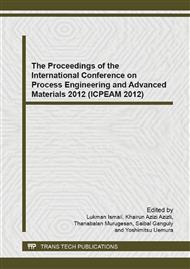[1]
R. A. Meyers, D. A. Hunt, Handbook of Petroleum Refining Processes, McGraw-Hill, (2003).
Google Scholar
[2]
A. K. Das, E. Baudrez, G. B. Marin, and G. J. Heynderickx, Three-Dimensional Simulation of a Fluid Catalytic Cracking Riser Reactor, Ind. Eng. Chem. Res., 2003, 42 (12), 2602-2617• DOI: 10. 1021/ie020744g • Publication Date (Web): 22 April (2003).
DOI: 10.1021/ie020744g
Google Scholar
[3]
F. Hernandez-Jimeneza, J.R. Thirdb, A. Acosta-Iborraa, C.R. Mullerb Critical evaluation of Euler-Euler AND Euler-Lagranian modeling strategies in a 2-D gas fluidized bed, conference paper : CFB 10, May 1st through 5th, 2011, Sunriver, Oregon, USA, section 11-2.
Google Scholar
[4]
K.N. Theologos, N.C. Markatos, Advanced modeling of fluid catalytic cracking riser-type reactors, A.I. Ch.E. Journal 39, 1993, p.1007–1017.
DOI: 10.1002/aic.690390610
Google Scholar
[5]
Y. Zheng, X. Wan, Z. Qian, F. Wei, Y. Jin, Numerical simulation of the gas-particle turbulent flow in riser reactor based on k-e-kp-ep-Q two-fluid model, Chemical Engineering Science, 56, 2001, p.6813 – 6822.
DOI: 10.1016/s0009-2509(01)00319-0
Google Scholar
[6]
X. Lan, C. Xu, G. Wang, L. Wu, J. Gao, CFD modeling of gas-solid flow and cracking reaction in two-stage riser FCC reactors, Chemical Engineering Science 64 (2009) 3847 – 3858.
DOI: 10.1016/j.ces.2009.05.019
Google Scholar
[7]
S. Vaishali, S. Roy, P. L. Mills, Hydrodynamic simulation of gas–solids downflow reactors, Chemical Engineering Science, 63, 2008, pp.5107-5119.
DOI: 10.1016/j.ces.2008.06.014
Google Scholar
[8]
D. Gidaspow, Multiphase Flow and Fluidization: Continuum and Kinetic Theory Description, Academic Press, New York, (1994).
Google Scholar
[9]
H. Arastoopour, P. Pakdel, M. Adewumi, Hydrodynamic analysis of dilute gas–solids flow in a vertical pipe, Powder Technol. 62, 1990, p.163–170.
DOI: 10.1016/0032-5910(90)80080-i
Google Scholar
[10]
M. Syamlal, T. O, Brien, Derivation of a drag coefficient from velocity–voidage correlation, U.S. Dept. of Energy, Office of Fossil Energy, National Energy Technology Laboratory, Morgantown, West Virginia, April, (1987).
Google Scholar
[11]
A. Almuttahar, F. Taghipour, Computational fluid dynamics of high density circulating fluidized bed riser: Study of modeling parameters, Powder Technology 185, 2008, p.11–23.
DOI: 10.1016/j.powtec.2007.09.010
Google Scholar
[12]
Matsen, J.M., Mechanisms of choking and entrainment, Powder Technology, 32, 1982, p.22–33.
DOI: 10.1016/0032-5910(82)85003-1
Google Scholar
[13]
Peng Li, X. Lan, C. Xu, G. Wang, C. Lu, J. Gao, Drag models for simulating gas–solid flow in the turbulent fluidization of FCC particles, Particuology, 7 , 2009, p.269–277.
DOI: 10.1016/j.partic.2009.03.010
Google Scholar
[14]
K. N. Theologos, A. I. Lygeros, N. C. Markatos, Feedstock Atomization Effects on FCC Riser Reactions Selectivity, Chem. Eng. Sci. 1999, 54, 5617.
DOI: 10.1016/s0009-2509(99)00294-8
Google Scholar
[15]
T. A. Berry, T. R. McKeen, T. S. Pugsley, and A. K. Dalai, Two-Dimensional Reaction Engineering Model of the Riser Section of a Fluid Catalytic Cracking Unit, Ind. Eng. Chem. Res., 2004, 43 (18), pp.5571-5581• DOI: 10. 1021/ie0306877 • Publication Date (Web): 21 April (2004).
DOI: 10.1021/ie0306877
Google Scholar
[16]
A. Gupta, D. Subbarao, Model for the performance of fluid catalytic cracking (FCC) riser reactor: Effect of feed atomization, Chemical Engineering Science, 56(2001), 4489–4503.
DOI: 10.1016/s0009-2509(01)00122-1
Google Scholar
[17]
A. Gupta, D. Subbarao, Effect of feed atomization on FCC performance: simulation of entire unit, Chemical Engineering Science, 58(2003), p.4567–4579.
DOI: 10.1016/s0009-2509(03)00341-5
Google Scholar
[18]
J. A. Souzaa, J. V. C. Vargasa, O. F. Von Meiena, and W. Martignonib, Numerical simulation of FCC risers, Engenharia Térmica, n؛ 4, 2003, pp.17-21.
Google Scholar
[19]
R. K. Gupta, V. Kumara, V.K. Srivastavab, Anew generic approach for the modeling of fluid catalytic cracking (FCC) riser reactor, Chemical Engineering Science 62 , 2007, p.4510 – 4528.
DOI: 10.1016/j.ces.2007.05.009
Google Scholar
[20]
R. Bader, J. Findlay, T.M. Knowlton, Gas/solids flow patterns in a 30. 5cm diameter circulating fluidized bed, In: Basu, P., Large, J.F. (Eds. ), Circulating Fluidized Bed Technology 2. Pergamon Press, Oxford, UK, 1988, p.123–137.
DOI: 10.1016/b978-0-08-036225-0.50016-2
Google Scholar
[21]
International Conference on Circulating Fluidized Beds and Fluidization Technology , CFB 10, May 1st through 5th, 2011, Sunriver Resort, Sunriver, Oregon, USA.
Google Scholar


